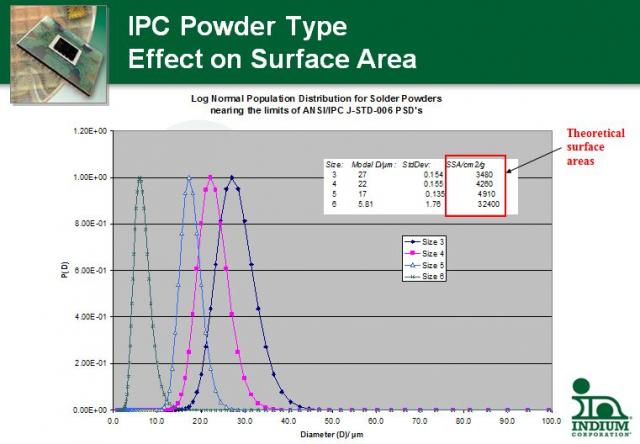Solder powder particle size and shape impacts the functionality of solder paste in many ways: printing/dispensing/dipping; solderballing; graping; voiding; tack and so on.
For this reason, I just spent an interesting couple of months leading a cross-industry (two solder paste suppliers and two solder paste users) group to help my old friend Brian Toleno, chair of the IPC 5-24b (Solder Paste Task Group) put the finishing touches to the final version of the J-STD-005A. The concerns were with the definitions of powder size in paste: both the distribution and the “maximum allowable particle size”. We reached a nice pan-industry consensus, which should allow the J-STD-005A to see the light of day as a published document in 2012. I also saw some recent work by colleagues on the effect of particle size on surface area. I didn’t see the derivation of this work, so I want to show you how to calculate the surface area of solder powder in a paste.
Assume solder paste at a weight loading of x%. [Note that: As the solder powder size (diameter) decreases, the metal loading is usually also decreased by 0.5% or more to compensate for the boundary layer of thixotropic flux adhering to the particle surface, but let's make the first order assumption that x is independent of particle size]. So 1 gram of solder paste contains (x/100) grams of solder metal.
If the metal has a density of r (rho), then the volume of metal (v) per gram of solder paste:
v = x / (r * 100)
Let’s assume that the metal particles are monodispersed (i.e.: all the same diameter (d)), so the number of particles per gram of paste (n) is then simply v (total volume of metal per gram) divided by the volume of one particle (vp).
n = v / vp = x / (r * 100 * (4/3) * pi * (d/2)3 )
We can now also calculate the solder powder surface area (s) per gram of paste from our knowledge of n and the surface area per solder powder particle (sp):
s = n * sp = n *4 * pi * (d/2)2
It is a simple matter of algebra to show that the ratio of surface area to volume is merely an inverse of the particle radius or diameter (I’ll leave that as homework for you):
| Metal loading = | 90 | 90 | 90 | 90 | % |
| Metal density = | 8.4 | 8.4 | 8.4 | 8.4 | g/cm3 |
| Powder particle diameter = | 60 | 40 | 20 | 10 | microns |
| v(p) = | 0.000107 | 0.000107 | 0.000107 | 0.000107 | m^3 |
| .: in 1 gram of paste, n = | 9.47E+08 | 3.20E+09 | 2.56E+10 | 2.05E+11 | particles |
| surface area = | 10.71 | 16.07 | 32.14 | 64.29 | m^2 |
A while back, I did a little Excel numerical integration to show the effect of powder type on the population distribution, and hence how powder “type” (2,3,4,5 and so on) affects the surface area, with some assumptions thrown in about the width of the distribution. The results are shown below, and are pretty much as you would expect. As you go from type 3 to type 6, you see about a 10 fold increase in the surface area.

Cheers!
Andy


